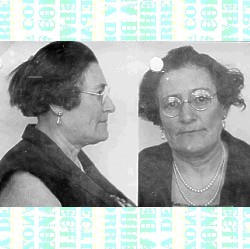
The Hanging of Eva Dugan
On February21, 1930, Eva Dugan was hanged for the murder of Tucson rancher
Andrew J. Mathis.
She was the only woman ever executed in Arizona, and her hanging brought
the state national
notoriety. She had gone to work as a housekeeper for Mathis in January
1927 and apparently was fired
after a couple of weeks. Shortly thereafter, Mathis disappeared along
with his Dodge coupe and some
personal possessions. Pima County Sheriff Jim McDonald, investigating
the disappearance, found
Mathis's cashbox missing, but his house otherwise In order. Neighbors
reported having been offered
some of Mathis's belongings for sale by Eva, but she also had disappeared.
A search of the ranch
turned up a charred ear trumpet (Mathis was hard of hearing)but nothing
else. Foul play was
suspected. McDonald began the work of tracing Eva, sending missing
persons notices describing her
and Mathis to police agencies all over the country. He found out she
had sold the Dodge for six
hundred dollars in Kansas City, Missouri (some accounts say Amarillo,
Texas), passing herself off as
Mrs. Andrew Mathis. She had told the salesman she needed the money
for her husband's surgery. A
background check revealed that Eva had been married five times and
that her husbands all had
mysteriously disappeared. She had a daughter living in White Plains,
New York and a father living in
California, but neither had seen her for several years. When McDonald
finally discovered her, she was,
in fact, living in White Plains working at a hospital. She was traced
there when alert postal authorities
intercepted a card she mailed to her father. McDonald arranged for
her extradition, and on March 4,
1927 she was returned to Arizona. She was tried on charges of car theft,
found guilty and sentenced to
prison. Nine months later, a tourist camping overnight at the Mathis
ranch uncovered a shallow grave
while trying to set a tent post. The decomposing body was identified
as that of Andrew J. Mathis. Eva
Dugan was charged with murder. The evidence against Eva all was circumstantial.
There were no
fingerprints, no witnesses, and the only thing Eva would admit to was
that she and Mathis had
quarreled. Nevertheless, after a brief trial, she was found guilty
of murder in the first degree and
sentenced to hang. For two years, her supporters worked to have her
sentence commuted by the
governor, while Eva gave interviews to the press, charging a dollar
per visit. On February 21, 1930,
having exhausted all avenues of appeal, she was hanged. In a gruesome
footnote, her body separated
from her head, which rolled at the feet of the spectators.
Reproduced from Arizona Capitol Times, December 1, 1995.
Stop it Controversy erupted with long-ago gallows case
A convicted murderess, 52-year-old Eva Dugan, was hanged at 5:02 a.m.
Feb. 21,1930, in Arizona
State Prison's death house. It was the beginning of the end for the
scaffold in Arizona. For when Mrs.
Dugan plunged through the trap door and hit the end of the rope with
a bouncing jolt, her head snapped
off and rolled into a corner. There was an immediate, horrified widespread
demand that a more
humane means of execution such as a new gas chamber - be substituted
for the unreliable gallows.
Mrs. Dugan had been convicted of killing A J Mathis, an elderly Tucson
rancher, in January 1927.
After the slaying she fled with a mysterious drifter, a young man known
only as "Jack." Mathis'
skeleton. encrusted with lime and with a gag still in its teeth, was
found almost a year later in a 100-to-l
happenstance. A camper from Oklahoma, J. F. Nash, discovered the rancherís
shallow grave while
driving a tent stake. The preliminaries to Mrs. Dugan's beheading were
routine enough. During the day
and night before the execution she visited with friends and newsmen.
She made small jokes - some of
them a bit macabre - and from time to time glanced at the clock. She
told a reporter for The Arizona
Republic that "I am going to my Maker with a clear conscience. I am
innocent of any murder and God
knows I am." Until she left the women's cell block for the death house,
Mrs. Dugan was sure she
would be spared, that "the attorney general is probably on his way
here now."
Shortly after midnight the prison grapevine spread the news that she
would cheat the gallows, that, with
the aid of friends, she would commit suicide She had hidden a bottle
of raw ammonia in her bunk, a
search revealed, and a second search turned up three razor blades in
the collar of her dress.
The small procession to the death house was led by a veteran guard,
"Daddy" Allen. Two other guards
flanked Mrs. Dugan and they were followed by the prison chaplain, the
Rev. Walter Hoffman, who in
later years was chairman of the state parole board. She seemed composed
as she mounted the
scaffold and told the guards "not to hold my arms so hard: people will
think I'm afraid" She swayed
slightly as she stood on the trap door. She closed her eyes and shook
her head when the warden Lo
Wright asked her if she had any last words. She was buried in a Florence
cemetery in a beaded,
jazz-age silk dress she had made while awaiting execution, and had
paid for her own coffin by selling
handkerchiefs she embroidered in her cell. Seventy-five persons
- including seven women - watched
the execution. Reproduced from the Arizona Republic, June 30, 1972.